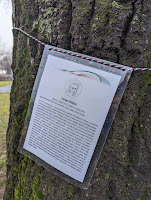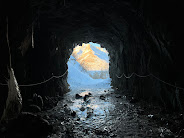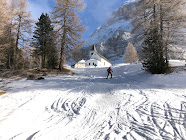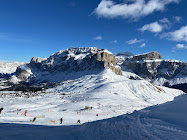Overview ~ Hike 1 ~ Hike 2 ~ The Area




Left: Walking down the Valbiolo ski run in twilight approaching Passo del Tonale.
Center left: Tracks for hike 1.
Center right: Walking into the sunset at Passo del Tonale.
Right: Tracks for hike 2.
Overview
Last year, we did two late winter hikes, one west of Ponte di Legno and one east at Passo del Tonale: Two Late Winter Hikes Near Ponte di Legno, Italy. This year, we stayed at a rented house in Passo del Tonale over the New Year. To add diversity to our days instead of just skiing (see How I Learned to Like Skiing – 7 Simple Rules), we looked for hikes to do. Here, we show two simple hikes of under two hours that we did on Jan 2 and Jan 3, 2024. There are hikes more waiting to be discovered in this area.
Both hikes were done in the late afternoon, so we hiked into dusk for both. Start earlier if you can.
Hike 1: Tour delle Marmotte
Duration: 1.25 hours
Elevation: 60 m gain (estimate)
Length: 6 km
Our path on this day we cut short because of waning light and a freezing wind! Otherwise, we would have taken the road up to the cozy
Ospizio San Bartolomeo (now called Hotel/Restaurant Mirandola). We, in fact, visited this hotel/restaurant twice in the days before this hike. We include some of those photos here. We had a nice lunch at Ospizio one day and an afternoon hot drink on another.
On the way back into town for hike 1 we stopped at the
Panificio Pezzani to get some strudel to take home for dessert! Don’t miss it.
Passo del Tonale is split between the regions of Lombary (Lombardia in Italian) and Trentino-South Tyrol (Trentino-Alto Adige in Italian). The dividing line is at the landmark Military Memorial Passo del Tonale (Sacrario militare del Tonale). (See
Street Sign Language Lesson XL.)
We started the walk
here, near the area for campers.
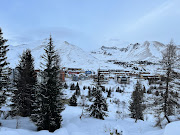

 Left: Passo del Tonale view north from Tour delle Marmotte trail.
Left: Passo del Tonale view north from Tour delle Marmotte trail.
Center and right: Tour delle Marmotte trail with fresh snow between trees.
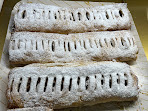


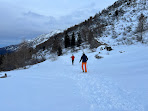
Left: Strudel from Panificio Pezzani, Passo del Tonale.
Center left: View from Hotel Mirandola toward sunset and Valbiolo chairlift.
Center right: Walking near Ospizio San Bartolomeo/Hotel Mirandola.
Right: Starting off on the Tour delle Marmotte trail.
Hike 2: Walk to Galleria Alveo
Duration: 1.5 hours
Elevation: 235 m
Length: 8.5 km
Last summer, we took the gondola up to see the Presena Glacier (see
Presena Glacier – A summer visit to the covered glacier). On this hike, we follow the path partly up to the glacier from the pass. Our turnaround point is the Alveo tunnel (Galleria Alveo), a short tunnel through the mountain. The tunnel was made during WWI. If you continue on this trail, you would reach the ex-military village of Monticelli (dating to WW1) and Rifugio Capanna Presena. This is numbered trail 281. (Other references and photos:
here and
here.)
Alveo in Italian is “riverbed”, referring to the riverbed plateau the trail takes you to. The river is caused by glacier runoff.
Hold on to the ropes in the tunnel. It was very slippery even though it didn’t look to be so.
We started the walk
here, near the area for campers. This trail is called 723 – Tour delle Marmotte, which we walked part of in Hike1. Instead of following Marmotte all the way, at this point we caught the trail to Presena (
here or
here if there is a lot of snow).
Left: Trail sign for CAI 281.
Right: View from Trail 218 looking east, near the Galleria Alveo.
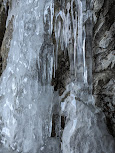

 Ice formations in and near the Galleria Alveo.
Ice formations in and near the Galleria Alveo.


Left and center: Passo del Tonale in the late afternoon winter sun - Monte Tonale Occidentale visible.
Right: The CAI 281 trail and approaching the tunnel opening.
Galleria Alveo - a tunnel made during World War I. Why are tunnels fascinating?
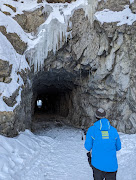

 Galleria Alveo - a helmet might be smart to wear inside given those icicles!
Galleria Alveo - a helmet might be smart to wear inside given those icicles!
The area
Eastern Alps
--|Southern Rhaetian Alps (28 in the
SOIUSA classification of the Alps, highest peak Ortler at 3,905 m)
--|--|Adamello-Presanella Alps (II/C-28.III SOIUSA, highest peak Presanella at 3,558 m)
The Adamello-Presanella Alps Alpine group is a mountain range in the Southern Limestone Alps mountain group of the Eastern Alps. It is located in northern Italy, in the provinces of Trentino and Brescia. The name stems from its highest peaks: Adamello and Presanella. The Tonale Pass separates the Adamello-Presanella Alps from the Ortler Apls to the the north.
![[Ranunculaceae] Helleborus niger - seen in Bergamo, Italy [Ranunculaceae] Helleborus niger - seen in Bergamo, Italy](https://blogger.googleusercontent.com/img/b/R29vZ2xl/AVvXsEgSmu9sn-0PCoXOnrlGwx8So9vaFui_tx82_9ncAWck3JpfpXedtKzAnIt6AuRyi_MjXd14SK_NcBbXvJhp-5FP1v_jrfuro87VPSlUNn4LwoKI54nHRmb-xXH0nWJKmwqlmYgcXhIOZJjf4csBLSEpNXFPNjAMnMLzGhQErMAxZFYAXXfkdphY38mGoQ/w232-h174/%5BRanunculaceae%5D%20Helleborus%20niger%2001.jpg)
![[Ranunculaceae] Helleborus niger - seen in Bergamo, Italy [Ranunculaceae] Helleborus niger - seen in Bergamo, Italy](https://blogger.googleusercontent.com/img/b/R29vZ2xl/AVvXsEgmocdNOIGm7vIe1jb2ff_OErOXrTBFd0JgDXEMqCYDs2p2BpCuBHlJ35aPb0sRUjI7JAIo7F6-0vMIRBcSp__3TgPUBi-5oPmag3bhRMVqj2Nw-b_IhO8xGXPDLXk4RXctlYhw-T3G2VxH6gwo6RvNB1lo4o8da4IQo3cNPNKeAXnG3HeWkhVF_ogIMw/w131-h175/%5BRanunculaceae%5D%20Helleborus%20niger%2004.jpg)
![[Ranunculaceae] Helleborus niger - seen in Bergamo, Italy [Ranunculaceae] Helleborus niger - seen in Bergamo, Italy](https://blogger.googleusercontent.com/img/b/R29vZ2xl/AVvXsEjXiuy4Eyxf-yMefLVM7aPyHYyoCoYDX7eykSO61_72q6ME-11b34WyEVj4c9E_G0Pyq83eF0XS38bcDJOMKHZ8zleguzt3332C5T2PuaKKa24ZsOJbmrznSTxFMeceZskcg9peFU9GHq_4nYVFYdRdogmUcssodOlXQrL8Fgji8JyEJaboq8pizIIvLg/w131-h174/%5BRanunculaceae%5D%20Helleborus%20niger%2005.jpg)
![[Ranunculaceae] Helleborus niger - seen in Bergamo, Italy [Ranunculaceae] Helleborus niger - seen in Bergamo, Italy](https://blogger.googleusercontent.com/img/b/R29vZ2xl/AVvXsEijtews5xGocO3KFnIe0PKglmbX76go1MVCklMpVfeSmdseArBbeHuo6AG7ERLH2i2UrvcrzpYiNmG0OLLiNV0cJfqDy2laD9_tzvbzqYE9KzV9FTlTxo4SlVA7iKfcL5rVVIBUMII7gkmvqDGZnme35DHo2y5blMsXth0Vnp5THAvvHAfcQskiIDJ-Kg/w200-h150/%5BRanunculaceae%5D%20Helleborus%20niger%2010.jpg)
![[Ranunculaceae] Helleborus niger - seen in Bergamo, Italy [Ranunculaceae] Helleborus niger - seen in Bergamo, Italy](https://blogger.googleusercontent.com/img/b/R29vZ2xl/AVvXsEgZwPIViy4cGAFmR02EBlveofbMO5M9jiLTBpZG720U5NbjFmOCCJOYm11Am0BTyM_JOtKbxx8eQ0TV_nBgUo2nTwTz9YpzOayK0GcYoskbmJJAYJoHO_X3AqadnLFITD5ijd74w_wVtUGN1GdFBfmWtR8hbkuUrtBQJ83J3-oW3Gz1jhKr3Y-RpMZ3KA/w112-h150/%5BRanunculaceae%5D%20Helleborus%20niger%2002.jpg)
![[Ranunculaceae] Helleborus niger - seen in Bergamo, Italy [Ranunculaceae] Helleborus niger - seen in Bergamo, Italy](https://blogger.googleusercontent.com/img/b/R29vZ2xl/AVvXsEh18dylvzD3JcepKb1-GFJQBWf8mYBpmBNYzcy0GrQpdPArCz-WjCjV6QP7E5ld3SE4TQPfx_IpzvEc94EM26VGyvYIr0cJQaLn7HZDbcfvbUBgtVA4PlUkV0WlCFszr_8-ZYTfaRw4zQnMWmkzrMQP-_PrxeCaVHzV0oKcaIkrXoS7PF42sezF9h4pZw/w113-h150/%5BRanunculaceae%5D%20Helleborus%20niger%2003.jpg)
![[Ranunculaceae] Helleborus niger - seen in Bergamo, Italy [Ranunculaceae] Helleborus niger - seen in Bergamo, Italy](https://blogger.googleusercontent.com/img/b/R29vZ2xl/AVvXsEiL9wKkJGG0SxYnUxFZOTNnUCV2PXDsjHQMJy590MqghS9F8oXrsib7FKcNy1fYwUhs21_IBZ-AqpfqX9hgO80ZL8kr6sINiv8oMuOduqaLIDii-rLZjXmXp3BqlkgZsw0Mfa72EHF6Ll6cCamOR1h1nE_8vNNLnAOmM2I-kyr3zcxC1uQIbKMK8H91tQ/w113-h151/%5BRanunculaceae%5D%20Helleborus%20niger%2007.jpg)
![[Ranunculaceae] Helleborus niger - seen in Bergamo, Italy [Ranunculaceae] Helleborus niger - seen in Bergamo, Italy](https://blogger.googleusercontent.com/img/b/R29vZ2xl/AVvXsEhLu9UG5qRCnhFqC832IQVTFDaurZXJ5OJ886rGxJswHiYE4NCkQKVlMHIammVQuR2RIt6UEQA3iJ7nIC4ibVeaChWp-6VNLxaiQfWyXDKQHF3Wk03Lr00zmC_6u8GcC8UadLmzw_VabNPuFJ2NV6HuUY-4RyFz5604tpTO_cD7VTFpdtocb67LZQQJ5A/w183-h138/%5BRanunculaceae%5D%20Helleborus%20niger%2006.jpg)
![[Ranunculaceae] Helleborus niger - seen in Bergamo, Italy [Ranunculaceae] Helleborus niger - seen in Bergamo, Italy](https://blogger.googleusercontent.com/img/b/R29vZ2xl/AVvXsEjFbICCKELazkoMwnUvCaEKRvLgRbpEFkfMrCR9Ehi_V49cXXUlxIBTM0rUqj-98g_gtxcDFwesimf6QULICXQWDUDkfapiRXFxkneMA8NVptEebTGxVRH7cEPQLxBdH32wqiBP84GKrwq_A0QUzLhlbFn3OX1WTTKq09te9A5DJLjcRjPQhwcRXpj9UQ/w182-h138/%5BRanunculaceae%5D%20Helleborus%20niger%2008.JPG)
![[Ranunculaceae] Helleborus niger - seen in Bergamo, Italy [Ranunculaceae] Helleborus niger - seen in Bergamo, Italy](https://blogger.googleusercontent.com/img/b/R29vZ2xl/AVvXsEg7sLKToWa9HO8sctcztNW65yZX4TcaS0T_QMKViHClNmzGDppB1_HaBaWclE-C4TM2eKLVrl4LlaP7rXWqCSRCW4baPHXgzoN4bz1WPf9zjKjqK_evgi2hUh-d9yw9rIPsNnicKREbQ8lCo2pwDb8kGGk_boRTumhMHE3FEAiXhCi_EBAwhgz_dTwU1g/w184-h138/%5BRanunculaceae%5D%20Helleborus%20niger%2009.JPG)








